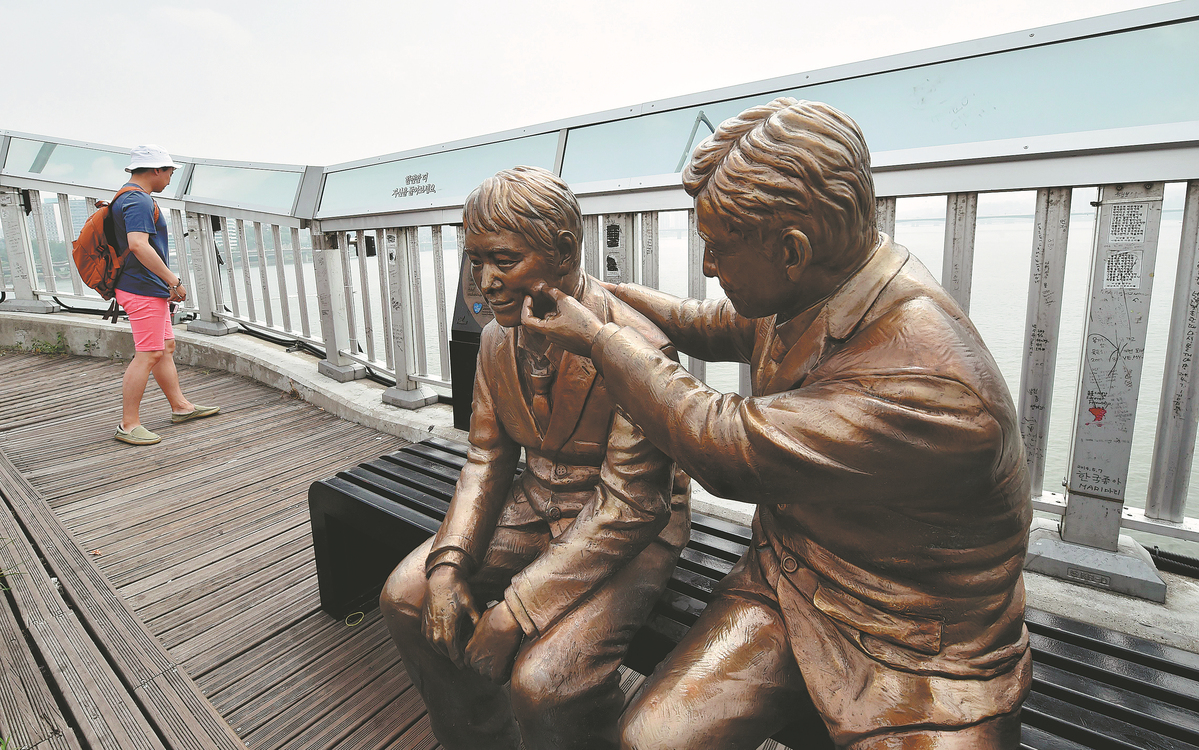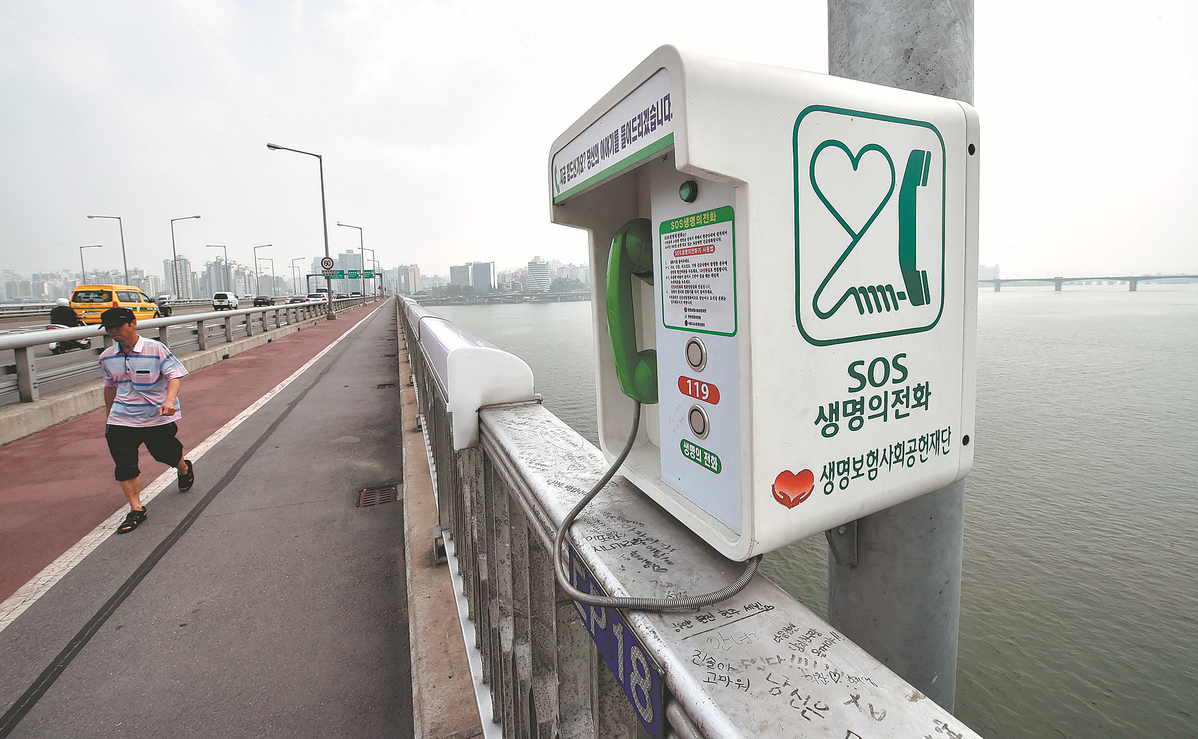
A statue of a man comforting a person is placed to dissuade suicides on Mapo Bridge, a common site for suicides, over the Han River in Seoul. South Korea has recorded the highest suicide rate among members of the Organization for Economic Cooperation and Development since 2003. JUNG YEON-JE/AFP
Editor's note: In this weekly feature China Daily gives voice to Asia and its people. The stories presented come mainly from the Asia News Network (ANN), of which China Daily is among its 20 leading titles.
The Seoul metropolitan government on Oct 28 introduced a set of measures — including increasing the staff of its 24-hour call center for people struggling with suicidal impulses — to halve its current suicide rate by 2030.
It aims to shift its current suicide prevention policy, from currently solely focusing on high-risk groups, to addressing the broader public.
"We want to shift the focus of our policy to a more comprehensive approach that empowers our citizens to take care of their mental health in their daily lives, while also reducing feelings of loneliness and isolation, and minimizing the risk of suicide in return," Kim Tae-hee, head of the municipal citizens' health bureau, said in a news briefing.
"The plan is to implement a proactive, robust approach to prevent suicidal thoughts from ever occurring," Kim said.
South Korea has held the highest suicide rate among members of the Organization for Economic Cooperation and Development, or OECD, since 2003. It recorded an uptick in suicide cases last year, reversing a short-lived downward trend.
According to the country's Statistics Korea agency, 13,978 people took their own lives last year, which translates to 27.3 deaths per 100,000 people. This marks an 8.5 percent increase from the 2022 figure of 25.2 deaths.
The increase follows a one-year decline between 2021 and 2022, when the rate dropped from 26 to 25.2.
The figures indicate that suicide ranked as the fifth most common cause of death in South Korea, constituting 4 percent of all deaths. Cancer topped the list, accounting for 24.2 percent.
But it was the number one cause of death for those aged 10-19, and in their 20s and 30s. Among people in their 20s, 52.7 percent of deaths were suicides, followed by those aged 10-19 at 46.1 percent, and the 30-somethings at 40.2 percent. For people in their 40s and 50s, suicide was the second leading cause of death, following cancer.
The highest increase in the suicide rate was observed among those in their 60s, with a 13.6 percent rise. The second biggest increase was among those in their 50s with 12.1 percent, while teenagers followed closely behind at 10.4 percent.
In a separate dataset from the 38-member OECD, South Korea topped the chart with 24.8 deaths per 100,000 people last year, more than double the OECD average of 10.7.

A telephone for emergencies is placed on Mapo Bridge in Seoul. JUNG YEON-JE/AFP
Facing challenges
According to the city government, Seoul recorded its highest suicide rate last year since 2015: 23.2 per 100,000 residents.
"Recent findings show that one in two Seoul residents consider themselves psychologically troubled, while the proportion of people who have experienced feelings of depression also rose by 1.9 percentage points to 8.5 percent over the last five years," Kim from the citizens' health bureau said.
The city government added that Seoul's suicide rate was also 1.8 times higher than South Korea's as a whole when age standardization according to the OECD was applied.
Under the newly proposed plans, the city government plans to increase the number of personnel at its 24-hour call center to help individuals struggling with suicidal impulses. According to Kim, there are currently 12 employed at the call center, and the city government aims to increase the number to 30 by 2026.
Besides the call center, the city government also proposed to add another counseling channel through major messaging apps.
The city government will similarly provide subsidies for those who wish to receive professional psychological counseling services privately, with a subsidy of up to 80,000 won ($58) per session over an eight-week period. Starting with 20,000 people this year, the authorities aim to increase these numbers every year, to subsidize a total of 100,000 people by 2027.
By 2026, the city government aims to establish city government-run counseling centers in the 27 districts in Seoul, though such counseling services will not be available in English.
At the district-run counseling centers, mental health specialists and psychologists will provide initial mental health consultations and refer individuals to private psychological institutions if necessary.
The city government added that it will launch a community-based program that assigns community leaders, neighborhood doctors and store owners to identify individuals at high risk of suicide and refer them to counseling services for assistance. The program will mostly be focused on parts of the city with a high suicide rate, as well as those concentrated with single-person households and areas with a high rate of alcoholism.
Similarly, an overseeing committee for suicide prevention policies will be introduced. According to Kim, the committee will work to "more closely analyze suicide-related statistics and conduct psychological autopsy for suicides".
The committee will also work to develop a suicide prevention manual to help the city government identify suicidal individuals.
THE KOREA HERALD, SOUTH KOREA